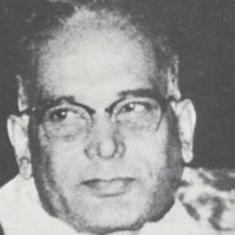As in life, cricket too can often provide intriguing scripts.
On Friday, in an almost empty Viv Richards Stadium in Antigua, Virat Kohli, India’s current Test captain and arguably the best batsmen of his generation, scored his first double century in the format. In doing so, he rewrote quite a few records. Chief among them: becoming the first Indian Test captain to score a double century away from home.
The double ton also came at a timely point in Kohli's career: already close to superhuman in the limited-overs format, with this landmark he shook away any nagging doubts anyone had over his Test match form.
Just across the pond on Saturday, England’s hugely-talented Joe Root began the second day of the second Test against Pakistan in Manchester on his overnight score of 141. Whether Kohli’s double century played on his mind or not is not known, but it was clear Root was in big innings mode.
The Yorkshire player had been castigated in the build-up to this Test for throwing away his wicket after being set in the first Test, which Pakistan won. In Manchester, though, Root traded in much of his flamboyance for solidity with the net result being a masterful innings of 254, giving England a massive score of 589 for 8 declared, and putting them in a very good position to wrest back the advantage from Pakistan.
Most fans, especially Indians, will baulk at the thought of comparing Kohli with Root. It is generally accepted that Kohli is by far the better batsman and there are enough compelling arguments for that. Over the last two years, Kohli has been dominant in all formats of the game and has been in extraordinary form. Quite clearly, he is head and shoulders ahead of the field.
More alike than you’d think
And yet, in Test cricket at least, there are reasonable grounds for comparison. They have similar records, and made their Test debuts a year of each other: Kohli in 2011, Root in 2012. Kohli’s 42 Tests so far have brought him 3194 runs with 12 centuries at an average of 46. Root, in comparison, has played 44 Tests at a much higher average of 55, but with two less centuries to his name.
The difference in ages is also minimal: Kohli is 27 while Root is 25.
They are similar and combative personalities, who have put immense work into their batting. Kohli, who had a tendency to display an ugly, aggressive streak, has channelled that aggression into his batting, which has made him world-class. Root may not have been as openly combative, but he has always had a competitive streak in him, as showcased by the ugly brawl he had with David Warner during the 2013 Ashes.
One of Kohli’s few low points in an otherwise glittering career came, coincidentally, in England during the 2014 tour, when he found himself vulnerable against the swinging and seaming ball outside off. But he went back and put in hours of work on this. Today, the weakness has turned into a strength and his flowing cover drive is one of his strongest weapons.
Similarly, even Root has worked long and hard to overcome his initial technical weaknesses and add a measure of steel to his batting. He has always had all the shots, but over the years he has put in far more thought into his shot-selection, which has added maturity to his batting.
A new era of batting
Along with Australian Steve Smith and New Zealand’s Kane Williamson, Kohli and Root have already been called the “Fab Four” batsmen of the current era. But between Kohli and Root, the debate over the better Test batsman has just become intriguing.
Root may have marginally the better record at present in Test matches, but as Kohli's backers will no doubt remind you, he has had the advantage of playing many more Tests at home. In comparison to only the 15 Tests that Root has played outside England, Kohli has played 25 out of his 42 Tests abroad.
The rivalry will, no doubt, acquire a new dimension when England tour India this winter. Do not be fooled by the easy-going demeanour both have adopted – they are both fiercely competitive athletes and the desire to be No. 1 will no doubt spur them on.
The most heartening aspect of this, for a cricket fan, is the sense of continuity Root's and Kohli's (along with Smith's and Williamson's) ascension to the throne has provided. With the retirements of quite a few legends in the past few years, there was a feeling that cricket in general had lost some of its best. But now, there is the sense that cricket fans are in for interesting times. All four of them are great batsmen – with unique, distinctive styles – and all four are young. What they have in common, of course, is an unadulterated love for the art of batting.










